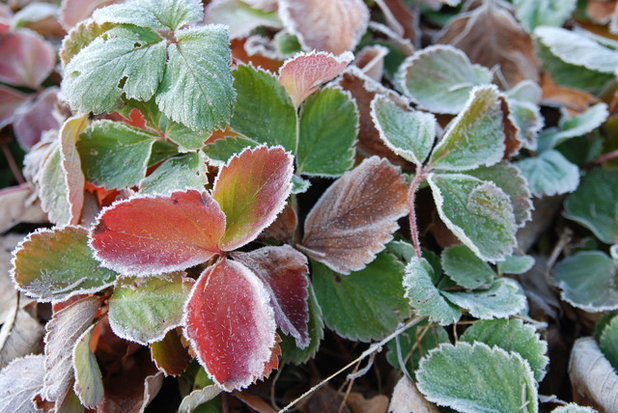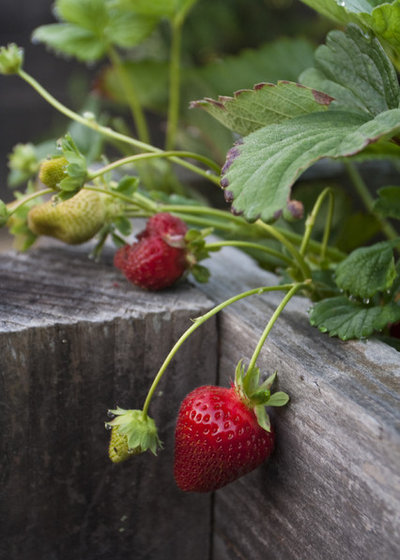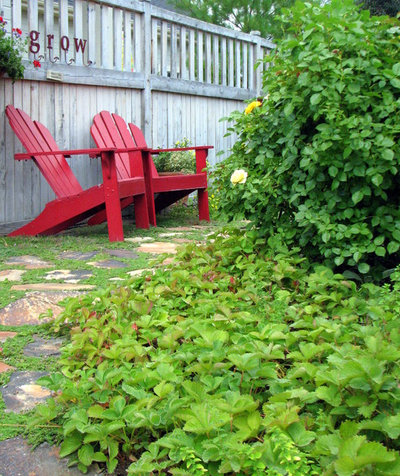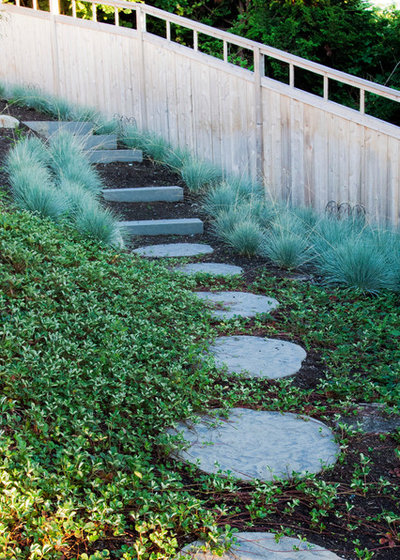I want my entry garden to be both beautiful and functional, so I’ve designed it with a mix of plants that offer multiple seasons of interest along with culinary benefits — and the path leads right up to my kitchen door. There’s woolly thyme growing among the stones; perennial chives and other herbs are planted along the walkway and mixed in among boxwood and other shrubs; and along with creeping juniper and bearberry, I’ve added strawberries as a ground cover.
Strawberries aren’t just for pots and raised garden beds; they make a good lawn alternative or ground cover for sunny areas, and their foliage is evergreen, which creates curb appeal during the winter doldrums. So if you’re thinking of ways to make your home garden more sustainable with crops that will feed your family and friends, think about adding strawberries — they’re a tough perennial and surprisingly easy to grow.

Paintbox Garden
Botanical name: Fragaria x
ananassaCommon name: Strawberry
Where it will grow: Hardy to -40 degrees Fahrenheit (USDA zones 3 to 8;
find your zone)
Water requirement: Normal to moist soil
Light requirement: Full sun
Mature size: 8 inches tall; spreads by runners to form clumps
Benefits and tolerances: Flowers and fruit support wildlife; established plants reliably produce crops of berries throughout summer months; exceptionally hardy and cold tolerant.
Seasonal interest: Strawberries are a four-season plant. In early winter the serrated leaves turn lovely shades of red and look great with a touch of frost. The plants are evergreen, so they will persist through winter and hold up under a blanket of snow.
When to plant: Spring through fall

Shades Of Green Landscape Architecture
In May small white blooms appear among the leaves, followed by delectable fruit that’s high in fiber and vitamin C.
Distinguishing traits. The wild alpine strawberry has been cultivated for centuries. Modern hybrids all have white blossoms that produce red fruit on long stems. Plants multiply by sending runners along the ground.
There are both June-bearing and everbearing types. ‘Tristar’ is a good everbearing cultivar that produces fruit from spring to fall, and the berries are good for freezing, too.

Chuck B. Edwards - Breckon Land Design
How to use it. If you’re looking for a ground cover to fill in a sunny patch of ground, strawberries make a good alternative to nonedible ajuga or periwinkle (which also can both become invasive). They also make an excellent replacement for overgrown English ivy or Japanese spurge.
If you’re not into sharing fruit with birds and other wildlife, you can use bird netting — wrap a couple of layers loosely over plants and secure with stakes. When the berries are ripe, you can remove the netting and forage among the leaves for your daily supply.

Cathy Rosenhaus Garden Designs
Strawberries are low growing with attractive crowns, making them suitable for the front of a border or as an edging plant for garden paths. The edible front yard is a concept that’s growing as more homeowners want to make their yards more sustainable with organic, fresh-picked produce.
Combine strawberries with other edibles, like Italian parsley, lemon verbena and orange pot marigold, for a delightful cottage look.
Add plants to all-weather containers by the front door and tuck in cold-hardy pansies and cabbages to welcome the holidays with a little color.

The Watershed Company
Planting notes. Gardeners in warm regions (California and Florida, for instance) can plant now, but most bare-root crowns are available in early spring and can be planted as soon as the soil can be worked.
When the weather allows, clear space for new plants and amend the soil with compost to boost pH and improve tilth. If your winter is mild, prep your space now and research varieties that are suitable for your growing area; check with your local extension office or nursery for recommendations.
If you’re using strawberries as a ground cover, let the runners take root to form new plants, and trim back growth from around hardscaping pavers and pathways.
More: Fire and Ice: 8 Plants That Blaze Once Frost Hits





